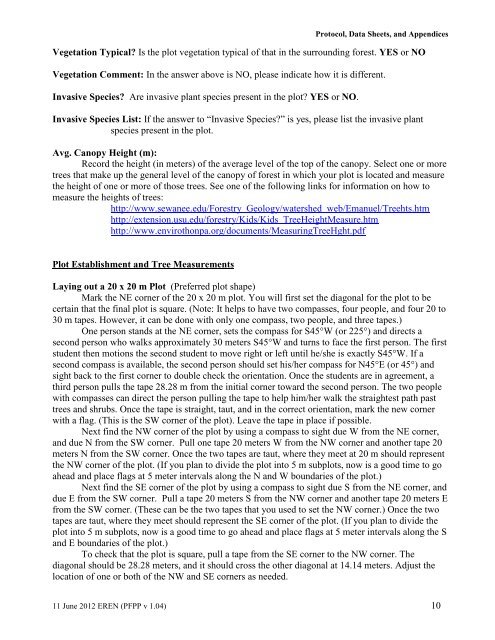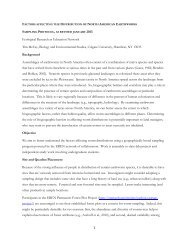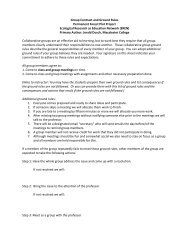Protocol, Data Sheets, and AppendicesVegetation Typical? Is the plot vegetation typical of that in the surrounding forest. YES or NOVegetation Comment: In the answer above is NO, please indicate how it is different.Invasive Species? Are invasive plant species present in the plot? YES or NO.Invasive Species List: If the answer to “Invasive Species?” is yes, please list the invasive plantspecies present in the plot.Avg. Canopy Height (m):Record the height (in meters) of the average level of the top of the canopy. Select one or moretrees that make up the general level of the canopy of forest in which your plot is located and measurethe height of one or more of those trees. See one of the following links for information on how tomeasure the heights of trees:http://www.sewanee.edu/<strong>Forest</strong>ry_Geology/watershed_web/Emanuel/Treehts.htmhttp://extension.usu.edu/forestry/Kids/Kids_TreeHeightMeasure.htmhttp://www.envirothonpa.org/documents/MeasuringTreeHght.pdf<strong>Plot</strong> Establishment and Tree MeasurementsLaying out a 20 x 20 m <strong>Plot</strong> (Preferred plot shape)Mark the NE corner of the 20 x 20 m plot. You will first set the diagonal for the plot to becertain that the final plot is square. (Note: It helps to have two compasses, four people, and four 20 to30 m tapes. However, it can be done with only one compass, two people, and three tapes.)One person stands at the NE corner, sets the compass for S45°W (or 225°) and directs asecond person who walks approximately 30 meters S45°W and turns to face the first person. The firststudent then motions the second student to move right or left until he/she is exactly S45°W. If asecond compass is available, the second person should set his/her compass for N45°E (or 45°) andsight back to the first corner to double check the orientation. Once the students are in agreement, athird person pulls the tape 28.28 m from the initial corner toward the second person. The two peoplewith compasses can direct the person pulling the tape to help him/her walk the straightest path pasttrees and shrubs. Once the tape is straight, taut, and in the correct orientation, mark the new cornerwith a flag. (This is the SW corner of the plot). Leave the tape in place if possible.Next find the NW corner of the plot by using a compass to sight due W from the NE corner,and due N from the SW corner. Pull one tape 20 meters W from the NW corner and another tape 20meters N from the SW corner. Once the two tapes are taut, where they meet at 20 m should representthe NW corner of the plot. (If you plan to divide the plot into 5 m subplots, now is a good time to goahead and place flags at 5 meter intervals along the N and W boundaries of the plot.)Next find the SE corner of the plot by using a compass to sight due S from the NE corner, anddue E from the SW corner. Pull a tape 20 meters S from the NW corner and another tape 20 meters Efrom the SW corner. (These can be the two tapes that you used to set the NW corner.) Once the twotapes are taut, where they meet should represent the SE corner of the plot. (If you plan to divide theplot into 5 m subplots, now is a good time to go ahead and place flags at 5 meter intervals along the Sand E boundaries of the plot.)To check that the plot is square, pull a tape from the SE corner to the NW corner. Thediagonal should be 28.28 meters, and it should cross the other diagonal at 14.14 meters. Adjust thelocation of one or both of the NW and SE corners as needed.11 June 2012 <strong>EREN</strong> (<strong>PFPP</strong> v 1.04) 10
Protocol, Data Sheets, and AppendicesIf you placed flags at 5 m intervals along the boundary, number them 5, 10, and 15 goingfrom N to S, and 5, 10, and 15 going from E to W. Next mark the interior 5 x 5 m subplotboundaries by pulling tapes S from the northern to the southern boundary at the 5, 10, and 15 mintervals.Tree Numbering, Tagging, and MappingIf you plan to number the trees, one method of involving students in the process is to initiallyuse colored pin flags that are numbered and later replaced with aluminum tags. The method thatfollows assumes that you have established 5 m subplots and that there will be 4 student groupsworking simultaneously to measure a plot within a single laboratory period. The main purpose for thedifferent colors of flags is to make it easy for a class with several student groups to easily see whereeach group should measure, and to aid in the mapping of the stems. If the entire plot will be measuredby one group, the trees can be numbered and mapped in one pass, and different colored flags may notbe necessary.Tree NumberingAssign a number to each stem so that it will be possible to relocate and remeasure the tree in afuture year. Trees with multiple stems will require multiple numbers. Multiple stems can either haveunique whole numbers, or may be recorded as a decimal (1.1, 1.2).No two stems in a single 20x20 m plot can have the same number. When plots are remeasuredin the future, smaller trees that grow above the 2.5 cm minimum measurement size should be giventhe next unused number. When a tree dies and falls to the ground, its number is “retired” forever.The method that follows uses pin flags to number each stem.Tagging TreesThere are a number of different methods for permanently tagging trees. Stem attachmentmaterials (nails) and tags should generally be aluminum (or plastic cables) rather than steel (unlesssmall staples are used) to prevent to injury people and equipment if the stem is sawn in the future,either after it dies, or as part of a harvest. Tags can be placed in the ground at the base of the tree, inthe tree stem near the ground (to make them less visible), near DBH (See page 16 for a method ofpositioning the tag and nail to ensure a consistent DBH measurement height), or can be hung fromsmall branches near the base of the tree. The method you choose will depend upon the size and age ofyour trees, desired investment of time and resources, and whether or not you want the tags to bereadily visible. Tags will need to be checked periodically because they are often chewed on bywildlife (or removed by people). Searching the internet for images of tree labels or tree tags also canprovide ideas from innovative ways that people have found to label their trees. The websites below(accessed 14June 2012) provide examples of tree tagging methods.Cable tag: http://www.proaxis.com/~johnbell/equipment/equip56a.htmStem tags: http://www.nationalband.com/nbtplant.htm#Tree_TagsUrban: http://www.tufc.com/pdfs/tree_labels.pdfFor temporary marking, place a pin flag at the base of each living or dead stem that is ≥ 2.5cm in diameter at 1.37 m DBH in each 5 x 5 subplot. (See note at the end of this paragraph.) It helpsto use four different colors of flags to mark the trees, and to use a different colored flag for each ofthe four subplots that make up one 5 m wide N to S transects. You will rotate the colors from onetransect to the next such that no two adjacent subplots have the same color (Figure 2). <strong>Plot</strong>s 1,9,7,and 15 are one color, 2,10,8, and 16 another color, 3,5,11, and 13 a third color, and 4, 6,12, and 14are a fourth color. If the class is divided into 4 groups, each group can be given a different pin flagcolor and can then flag each of the trees in the 4 plots designated to be that color.11 June 2012 <strong>EREN</strong> (<strong>PFPP</strong> v 1.04) 11
- Page 1 and 2: Permanent Forest PlotProject (PFPP)
- Page 3 and 4: Protocol, Data Sheets, and Appendic
- Page 5 and 6: Protocol, Data Sheets, and Appendic
- Page 7 and 8: Protocol, Data Sheets, and Appendic
- Page 9: Protocol, Data Sheets, and Appendic
- Page 14 and 15: Protocol, Data Sheets, and Appendic
- Page 16 and 17: Methods for Accurate DBH and DBH In
- Page 18 and 19: Protocol, Data Sheets, and Appendic
- Page 20 and 21: Protocol, Data Sheets, and Appendic
- Page 22 and 23: Site/Plot Data Entry Form (EREN Per
- Page 24 and 25: Tree Data Entry Form (EREN Permanen
- Page 26 and 27: Web Soil Survey Instructions (V
- Page 28 and 29: Web Soil Survey Instructions 7/3
- Page 30 and 31: Web Soil Survey Instructions 7/3
- Page 32 and 33: Web Soil Survey Instructions 7/3
- Page 34 and 35: ContentsPreface....................
- Page 36 and 37: EREN PFPP Appendix II1. Use the soi
- Page 38 and 39: EREN PFPP Appendix IIIFigure 3. The
- Page 41 and 42: 21.37 m1.37 m1.37 m1 m1.37 m1.37 m1
- Page 43 and 44: Estimating Stem Soundness (EREN PFP
- Page 45 and 46: NW51015SW15 10EREN PFPPAppendix VII




